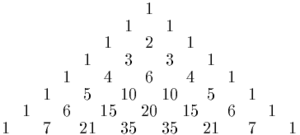Central binomial coefficient

In mathematics the nth central binomial coefficient is the particular binomial coefficient
They are called central since they show up exactly in the middle of the even-numbered rows in Pascal's triangle. The first few central binomial coefficients starting at n = 0 are:
Combinatorial interpretations and other properties[edit]

The central binomial coefficient is the number of arrangements where there are an equal number of two types of objects. For example, when , the binomial coefficient is equal to 6, and there are six arrangements of two copies of A and two copies of B: AABB, ABAB, ABBA, BAAB, BABA, BBAA.
The same central binomial coefficient is also the number of words of length 2n made up of A and B within which, as one reads from left to right, there are never more B's than A's at any point. For example, when , there are six words of length 4 in which each prefix has at least as many copies of A as of B: AAAA, AAAB, AABA, AABB, ABAA, ABAB.
The number of factors of 2 in is equal to the number of 1s in the binary representation of n.[1] As a consequence, 1 is the only odd central binomial coefficient.
Generating function[edit]
The ordinary generating function for the central binomial coefficients is This can be proved using the binomial series and the relation where is a generalized binomial coefficient.[2]
The central binomial coefficients have exponential generating function where I0 is a modified Bessel function of the first kind.[3]
The generating function of the squares of the central binomial coefficients can be written in terms of the complete elliptic integral of the first kind:[4]
Asymptotic growth[edit]
The asymptotic behavior can be described quite accurately:[5]
Related sequences[edit]
The closely related Catalan numbers Cn are given by:
A slight generalization of central binomial coefficients is to take them as , with appropriate real numbers n, where is the gamma function and is the beta function.
The powers of two that divide the central binomial coefficients are given by Gould's sequence, whose nth element is the number of odd integers in row n of Pascal's triangle.
Squaring the generating function gives
Comparing the coefficients of gives
For example, . (sequence A000302 in the OEIS)
Similarly,
(sequence A002894 in the OEIS)
Other information[edit]
Half the central binomial coefficient (for ) (sequence A001700 in the OEIS) is seen in Wolstenholme's theorem.
By the Erdős squarefree conjecture, proved in 1996, no central binomial coefficient with n > 4 is squarefree.
is the sum of the squares of the n-th row of Pascal's Triangle:[3]
For example, .
Erdős uses central binomial coefficients extensively in his proof of Bertrand's postulate.
Another noteworthy fact is that the power of 2 dividing is exactly n.
See also[edit]
References[edit]
- ^ Sloane, N. J. A. (ed.). "Sequence A000120". The On-Line Encyclopedia of Integer Sequences. OEIS Foundation.
- ^ Stanley, Richard P. (2012), Enumerative Combinatorics, vol. 1 (2 ed.), Cambridge University Press, Example 1.1.15, ISBN 978-1-107-60262-5
- ^ Jump up to: a b Sloane, N. J. A. (ed.). "Sequence A000984 (Central binomial coefficients)". The On-Line Encyclopedia of Integer Sequences. OEIS Foundation.
- ^ Sloane, N. J. A. (ed.). "Sequence A002894". The On-Line Encyclopedia of Integer Sequences. OEIS Foundation.
- ^ Luke, Yudell L. (1969). The Special Functions and their Approximations, Vol. 1. New York, NY, USA: Academic Press, Inc. p. 35.
- Koshy, Thomas (2008), Catalan Numbers with Applications, Oxford University Press, ISBN 978-0-19533-454-8.

























